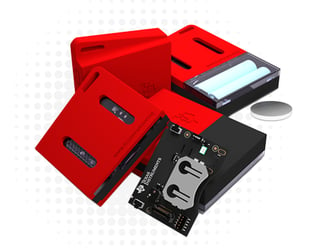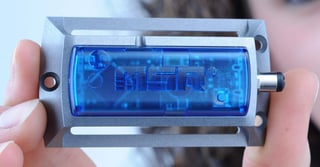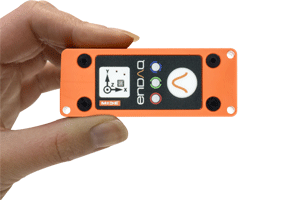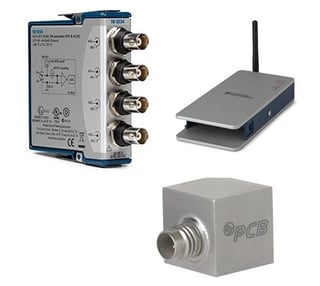
In this post I will list and explain the full range of vibration measurement systems readily available to a test engineer, or anyone in need of vibration measurement. As an applications engineer here at enDAQ (Note: enDAQ is a division of Mide), I often get asked by customers for alternative vibration measurement options to our enDAQ sensors. I believe these products meet the widest range of vibration measurement needs, but they are definitely overkill for some applications. And conversely these products don't have the functionality that some applications require.
In this post I will briefly discuss various vibration measurement options and provide links to these products. If you know you need wireless, check out a similar post highlighting wireless monitoring systems. And if you're interested in software options, check out our similar post on 8 different vibration analysis softwares available to you. At the end of this blog I've summarized some key specifications in a comparison table to help you determine the one that best meets your needs.
Vibration Measurement Systems
- TI's Sensor Tag
- Extech's VB300 Vibration Recorder
- Fluke 805 VIbration Meter
- MSR165 Vibration Data Logger
- enDAQ's Sensors
- National Instruments Based Vibration Measurement System
1. TI's SensorTag

Texas Instrument’s SensorTag is a great product that showcases TI’s Bluetooth low energy system as well as 10 different sensors. It comes in at the incredibly low price of less than $30 (you wonder if TI loses money on these?!). Through Bluetooth, you connect the device to your phone and you can see in real time the measurements of all ten sensors, including a triaxial accelerometer. Now, I’d hardly call it a vibration sensor though because it only samples up to 10 Hz (samples per second); but this is certainly a great product for a number of applications. There are a lot of development tools too so that you can incorporate various sensors and chips into your end system.
Pros
- Easy setup, free apps for smart phones
- 10 sensors (light, digital microphone, magnetic sensor, humidity, pressure, accelerometer, gyroscope, magnetometer, object temperature, and ambient temperature)
- So cheap, $30!
- Wireless (Bluetooth) data streaming
- Development platform which can be built upon for your application
Cons
- Very slow sample rate (less than 10 Hz)
- Meant more of an Internet of Things (IoT) development platform than a vibration measurement system
2. Extech's VB300 Vibration Recorder

The VB300 is a very cost effective vibration measurement instrument and is an entry level vibration recorder. Coming in at less than $300 it can be a great first option at quantifying your vibration environment. It’s definitely limited in sample rate (up to 200 Hz) and total storage (4Mbit or 112K samples per axis) but for some applications this as adequate. This product also claims to provide real-time feedback in both the frequency and time domain, which is certainly useful. The reviews on Amazon leave much to be desired for though and it seems that quality (as the price suggests) is not this product’s strength. This product also seems to be just a rebranded version of an even cheaper ($120) alternative made by a Chinese company, CEM's DT-178 data logger. That being said I continue to point customers to this product that have budget restrictions but need some vibration measurement data. It's perfect if you're looking to get a rough idea of the frequency content (so long as it's less than 60 Hz) in your vibration environment.
Pros
- Cheap, less than $300
- Real-time operation, including spectral data using an FFT (Fast Fourier Transform)
- Trigger options to start recording
Cons
- Slow sample rate (200 Hz)
- Poor quality (rebranded version of an even cheaper Chinese product)
- Replaceable battery is hard to procure
3. Fluke 805 Vibration Meter

The Fluke 805 vibration meter offers real time vibration analysis so that maintenance decisions can be made quickly and relativity accurately. It’s much different than the other products discussed in this post because it doesn’t really log any data (will keep the last 3,500 samples). When pressed against a piece of machinery (does make you question how accurate it is in this "mounting" configuration) it reads out the RMS vibration level and also uses some algorithm to rate the overall vibration of your bearing or machine. It is a bit pricey at just under $2,000 and it doesn’t offer enough information to do proper vibration analysis. But for quick go/no-go determination of your equipment’s vibration levels, a vibration meter like this product is an excellent choice.
Pros
- The simplest to use product: press against machinery and get vibration data!
- Fast sample rate (20,000 samples/second)
- Compatible with Fluke's Connect mobile application
Cons
- Minimal storage (3,500 samples) for vibration analysis
- Expensive at $2,000
4. MSR165 Vibration Data Logger

The MSR165 is great portable tool to measure and analyze vibration. It has two accelerometer options (±15g or ±200g) to meet either vibration or shock testing needs. With a noticeably higher sample rate option (1,600 Hz) than many of the other vibration data loggers on the market and expandable storage and battery options this product offers a great solution over the more “traditional” data acquisition systems. It also offers a host of customizable options which include added temperature, pressure, humidity, or light sensors and external analog inputs.
My issue with the product comes with the fact that there are almost too many options and as such, each unit must be made to order. As many of us know in the vibration testing community, when we need vibration testing equipment, we needed it yesterday! With everything being made to order the lead time is typically almost a month. Also, because they go through distributors only (some of which require a cut of 40%) their prices seem a little higher than I’d expect. All the different configurable options can add quite a bit of cost and before you know it, the instrument’s price exceeds $2,000. The product definitely still provides great value though and is a good solution for longer duration recordings especially.
Pros
- Higher sample rate than many other data loggers (1,600 samples/second per axis)
- Super customizable: larger battery option, added sensors (light, temperature, pressure, humidity), external inputs, expanded memory
- Very long battery life (claims up to 6 months, dependent upon sample rate and number of "events")
- MSR has other data loggers to meet a wide range of testing applications
Cons
- Long lead times, typically as much as 1 month
- High pricing, especially with added sensors/options (in excess of $2,000)
5. enDAQ Sensors

enDAQ sensors (formerly Mide's Slam Stick vibration data loggers) really kick up the sample rate and measurement range to make these products truly rival the "typical" vibration measurement system. The S3-D40 and S3-D16 (formerly Slam Stick C) is similar to the MSR165 yet has twice the sample rate (3,200 samples/second/axis) and comes in at a lower price ($1,000). The battery life approaches one full day which isn’t long enough for transportation; but it can be powered through the micro USB to extend the recording time. It also comes standard with 1GB of storage, enough for 500 million samples. Although the sample rate is still much higher than many other options, it can be too slow for some applications; and it is limited to only a ±16g vibration/shock measurement range. But at $1,000 it is a great tool that many companies could use on a near daily basis for vibration measurement. If you don’t have the time or budget for the more complex vibration instrumentation yet you still need high end vibration data, this may be the vibration measurement instrument you’re looking for.
enDAQ’s flagship vibration measurement tool, the polycarbonate S3 and aluminum S4 (formerly Slam Stick X), is unrivaled with its significantly higher sample rate (up to 20,000 samples per second per axis), and high measurement range options (up to 2,000g). With the much higher resolution (16 bit) and low noise characteristics this can also be used for very fine and small amplitude vibration measurement. This vibration measurement tool can be used for high end vibration and shock testing on your product or system for qualification and/or isolating certain vibration issues you may be experiencing. The product offers excellent value at $1,250 (additional for aluminum enclosure and other options) that can result in significant time and hardware savings for your business.
enDAQ offers a free enDAQ Lab software package that is available to download online. This free software plots the data generated on the enDAQ sensor and configures the recorders. Data export, FFTs, spectrograms, and many other features are available in this software. The enDAQ sensor's portability, ease-of-use, and high end hardware make this a truly unique product that rivals the performance of the "traditional" vibration measurement systems.
Pros
- Highest sample rate among data loggers (up to 20,000 samples/second per axis)
- Different measurement range options (±16g, 25g, 100g, 500g, or 2000g)
- Includes a temperature and pressure sensor at no cost
- Remarkably easy to use. Mount it, press the button, then download the data and begin your vibration analysis!
- Very durable, developed for the US Navy so it has been qualified for harsh vibration, shock, and EMI environments
- Comes with N.I.S.T. calibration certificate
- Short lead time, typically 1 to 2 business days
- Cost effective at between $1,000 and $2,000 depending on configuration
- Free vibration analysis software, the enDAQ Lab, that exports data to Excel and MATLAB
Cons
- Can't stream vibration data to perform vibration measurement in real time
- No synchronization between units - YET! enDAQ is developing a version with GPS for location and time synchronization
- Doesn't include external sensor options or embedded gyroscope - YET! A version with these capabilities is being developed
6. National Instruments Based Vibration Measurement System

Many people need or want real time vibration data to perform their analysis. National Instruments has a suite of products for general data acquisition and their LabVIEW software provides a means to interact with the real-time data being generated. There are a great number of different software and hardware systems available through National Instruments which would require a completely separate blog post(s) to go over. For the purpose of this comparison on different ways to measure vibration I selected a vibration measurement system with the type of specifications I would want as a test engineer. This type of vibration system is what I think most engineers picture as the "traditional" approach.
I selected the NI 9234 analog input module as the core DAQ (data acquisition) which has 4 channels of 24-bit data capture at up to 51,200 samples per second per channel. This module is specifically designed to interface with integrated electronic piezoelectric (IEPE) accelerometers; any such accelerometer with a +/- 5 volt output and up to a 2 mA excitation can be connected to this system. This will provide power to the accelerometer while it is simultaneously sampling the output, pretty cool! This module comes in at the cost of $1,823.
As part of this "ideal" vibration measurement system with real time data output, I selected a Wi-Fi module, the NI cDAQ-9191 to stream the data output wirelessly. This is only $400 and provides a great deal of functionality for someone who is trying to monitor vibration data in real time but somewhat remotely. If you don't want to run cables (other than power) to your vibration measurement system, this chassis is well worth the $400.
For the software package I went with the LabVIEW Full Development System at $2,999. I'm sure most of us know about LabVIEW but this software package is a graphical programming language to display and analyze measurement data in real time. This system includes extensive signal processing and analysis functionality. Many of you may already have a LabVIEW seat that you could use so you may not have to buy the software. Either way though you will need to spend quite a bit of time setting up the VI (virtual instruments). National Instruments also offers a software package specifically for sound and vibration measurement, at $1,999. This can save you a bit of set up time and money because it claims no programming is required. You won't necessarily be able to tailor the interface for your needs though and I don't think you could use this to run other systems, like you could with the LabVIEW development system.
For the accelerometer I selected a triaxial ceramic shear ICP accelerometer with 100 mV/g output, PCB Piezotronics's 356A15. This is a pretty impressive accelerometer with high sensitivity and a +/-50g peak output. The bandwidth is from 2 to 5,000 Hz and has less than 1% non-linearity and less than 5% transverse sensitivity. Its thermal dependency is pretty stable (it doesn't really need temperature compensation) and has a wide temperature operating range. There's obviously countless accelerometer choices out there (check out a blog post on how to select the right accelerometer for your application); but this would be at the top of my list for vibration measurement. The price is $1,035 for this accelerometer.
This brings the total system cost to $6,250; a savings of $1,400 can be made by forgoing the Wi-Fi module and opting for the base sound and vibration LabVIEW package. Of course this system has downsides in that you will need a computer (not very portable) and line power. The software effort can take quite a bit of time which delays testing and costs a significant amount of money. The lead times for some of these components, including the accelerometer, can sometimes be over a month resulting in additional delays. The other issue is that the DAQ module, although it has some shock & vibration testing, won't be able to handle some of the harsh environments you want your accelerometer to measure. That all being said, this system is pretty sweet! If you have the budget and the physical space available for this system, it's a compelling option for acquiring and analyzing vibration data.
Pros
- Very high sample rate (up to 51,200 samples/second per axis)
- Plots, logs, filters, and analyzes vibration data in real time
- Plug and play with countless accelerometer options
- Data can be used as part of multifunction system that can "think and respond" to vibration inputs
- High resolution at 24 bit (2^24, or about 17 million, "bins")
- Wireless streaming of vibration data over Wi-Fi
- Can use 4th channel for other measurement needs such as pressure or even an additional accelerometer
Cons
- Expensive at over $6,000
- Requires 4 to 5 times the physical space and weight
- Requires AC power supply
- Not stand-alone, requires software to run on nearby laptop
- Software can crash during data acquisition
- Labor hours required for setting up the hardware and software, not recommended for first time users
- Not very portable
- All hardware components aren't rated for the harsh environments where we are doing our vibration measurement
Overview of Vibration Measurement Systems
| Product Name | SensorTag | VB300 | Vibration Meter | MSR165 | enDAQ Sensor | LabVIEW System |
| Cost | $29 | $210 | $1,935 | $1,271 to $2,956 | $1,000 to $2,750 | $6,250 |
| Sample Rate (Hz) | 10 | 200 | 20,000 | 1,600 | 20,000 | 51,200 |
| Measurement Range (g) | 16 | 18 | 50 | 15 or 200 | 16, 25, 100, 500, or 2000 | Many options |
| Storage (Millions of Samples) | 0 | 0.50 | 0.004 | 2 | 1,000 | Unlimited |
| Resolution | 16 bit | 12 bit | 16 bit | 13 bit | 16 bit | 24 bit |
For a more in-depth look at vibration data loggers, I've rated my top 11 vibration data loggers which includes other competing products/customers. If you know you need wireless, check out a similar post highlighting wireless monitoring systems. Please don’t hesitate to reach out to us and ask which product we think will best meet your needs!
Additional Resources
If you'd like to learn a little more about various aspects in shock and vibration testing and analysis, download our free Shock & Vibration Testing Overview eBook. In there are some examples, background, and a ton of links to where you can learn more.
Related Posts:
- Vibration Analysis: FFT, PSD, and Spectrogram Basics [Free Download]
- 3 Types of Non-Contact Vibration Sensors
- MATLAB vs Python: Speed Test for Vibration Analysis [Free Download]
For more on this topic, visit our dedicated Vibration Loggers & Vibration Sensors resource page. There you’ll find more blog posts, case studies, webinars, software, and products focused on your vibration testing and analysis needs.
